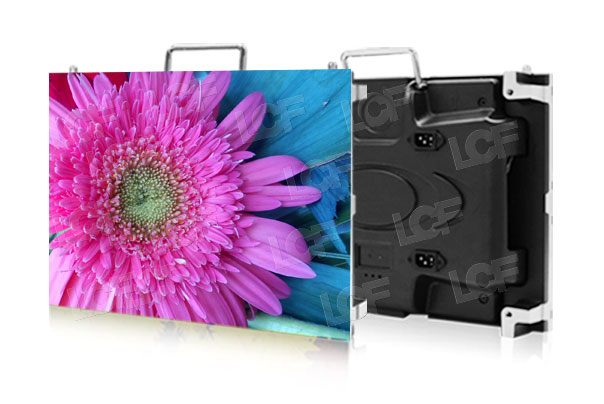Publisher: Supplier of LED Display Time: 2018-03-27 Views: 3824

The main material components used in the packaging of LED display devices include brackets, chips, die-bonding glue, bonding wires and packaging glue. SMD (Surface Mounted Devices) refers to the surface mount package structure LED, mainly including PCB board structure LED (ChipLED) and PLCC structure LED (TOP LED). This paper mainly studies TOP LEDs, and the SMD LEDs mentioned below all refer to TOP LEDs. The following introduces some basic development status in China from the aspect of packaging materials.
1. LED bracket
(1) The role of the stent. The PLCC (Plastic Leaded Chip Carrier) bracket is the carrier of the SMD LED device, which plays a key role in the reliability and light output of the LED.
(2) The production process of the stent. The PLCC bracket production process mainly includes metal strip punching, electroplating, PPA (polyphthalamide) injection molding, bending, five-sided three-dimensional inkjet and other processes. Among them, electroplating, metal substrates, plastic materials, etc. occupy the main cost of the stent.
(3) The structural improvement design of the bracket. Because the PPA and the metal are combined physically, the PLCC bracket will have a larger gap after the reflow oven at a high temperature, which will cause moisture to easily enter the device along the metal channel and affect reliability.
In order to improve product reliability to meet the high-quality LED display devices demanded by the high-end market, some packaging factories have improved the structural design of the bracket. For example, an optoelectronics company in Foshan City adopts advanced waterproof structure design, bending and stretching methods. To extend the water vapor entry path of the bracket, at the same time, multiple waterproof measures such as waterproof grooves, waterproof steps, and drainage holes are added inside the bracket. This design not only saves packaging costs, but also improves product reliability, and has been widely used in outdoor LED display products. Through the SAM (Scanning Acoustic Microscope) test of the air tightness of the LED bracket designed with the bending structure after packaging and the normal bracket, it can be found that the product designed with the bending structure has better air tightness.
2. Chip
The LED chip is the core of the LED device, and its reliability determines the life and luminous performance of the LED device and even the LED display. The cost of LED chips is also the largest in the total cost of LED devices. With the reduction of cost, the size of LED chips is getting smaller and smaller, which also brings a series of reliability problems.
As the size shrinks, the pads of the P electrode and the N electrode also shrink. The shrinking of the electrode pad directly affects the quality of the bonding wire, and it is easy to cause the gold ball to detach or even the electrode itself to detach during the packaging process and use process, and eventually fail. At the same time, the distance a between the two pads will also be reduced, which will cause an excessive increase in the current density at the electrodes, and the current will gather locally at the electrodes, and the unevenly distributed current will seriously affect the performance of the chip, causing the chip to have local temperature. Problems such as excessively high, uneven brightness, easy leakage, electrode drop, and even low luminous efficiency will eventually lead to a decrease in the reliability of the LED display.
3. Bonding wire
The bonding wire is one of the key materials of LED packaging. Its function is to realize the electrical connection between the chip and the pin, and it plays the role of importing and exporting the current between the chip and the outside world. Commonly used bonding wires for LED device packaging include gold wires, copper wires, palladium-plated copper wires, and alloy wires.
(1) Gold wire. Gold wire is the most widely used and has the most mature technology, but it is expensive, which leads to the high cost of LED packaging.
(2) Copper wire. Copper wire instead of gold wire has the advantages of low cost, good heat dissipation effect, and slow growth of intermetallic compounds during the wire bonding process. The disadvantage is that copper is prone to oxidation, high hardness and high strain strength. Especially in the heating environment of the bonding copper sintering process, the copper surface is easily oxidized, and the formed oxide film reduces the bonding performance of the copper wire, which puts forward higher requirements for process control in the actual production process.
(3) Palladium-plated copper wire. In order to prevent copper wire oxidation, palladium-plated copper bonding wire has gradually attracted the attention of the packaging industry. Palladium-plated copper wire has the advantages of high mechanical strength, moderate hardness, and good soldering ball, which is very suitable for high-density, multi-pin integrated circuit packaging.
4. Glue
At present, the glue for LED display device packaging mainly includes epoxy resin and silicone.
(1) Epoxy resin. Epoxy resin is easy to age, easy to get wet, has poor heat resistance, and it is easy to change color under short-wave light and high temperature. It has certain toxicity in the colloidal state. The thermal stress does not match the LED very well, which will affect the reliability and life of the LED. . Therefore, the epoxy resin is usually attacked.
(2) Silicone. Compared with epoxy resin, silicone has higher cost performance, excellent insulation, dielectric properties and adhesion. But the disadvantage is that the air tightness is poor and it is easy to absorb moisture. Therefore, it is rarely used in the packaging application of LED display devices.
In addition, the high-quality LED display also puts forward special requirements for the display effect. Some packaging factories use additives to improve the stress of the glue and achieve the effect of matte matte surface at the same time.